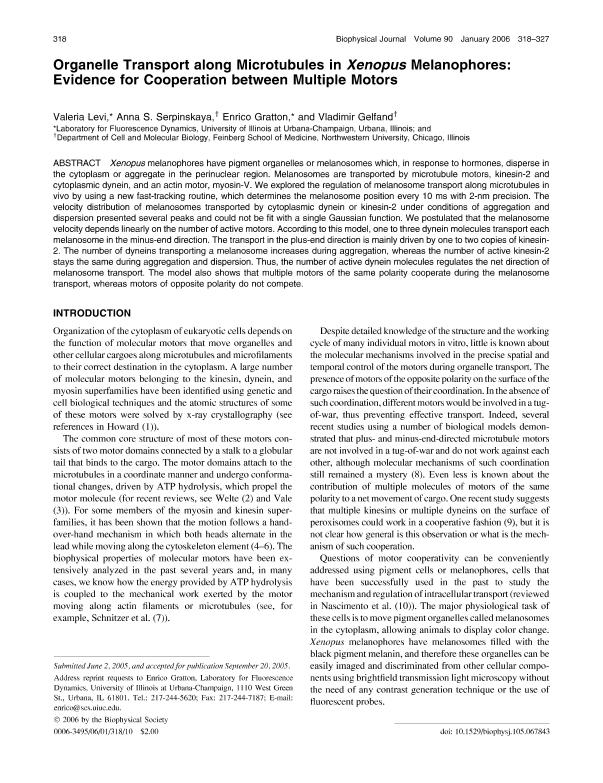Artículo
Organelle transport along microtubules in Xenopus melanophores: Evidence for cooperation between multiple motors
Fecha de publicación:
12/2006
Editorial:
Elsevier
Revista:
Biophysical Journal
ISSN:
0006-3495
Idioma:
Inglés
Tipo de recurso:
Artículo publicado
Clasificación temática:
Resumen
Xenopus melanophores have pigment organelles or melanosomes which, in response to hormones, disperse in the cytoplasm or aggregate in the perinuclear region. Melanosomes are transported by microtubule motors, kinesin-2 and cytoplasmic dynein, and an actin motor, myosin-V. We explored the regulation of melanosome transport along microtubules in vivo by using a new fast-tracking routine, which determines the melanosome position every 10 ms with 2-nm precision. The velocity distribution of melanosomes transported by cytoplasmic dynein or kinesin-2 under conditions of aggregation and dispersion presented several peaks and could not be fit with a single Gaussian function. We postulated that the melanosome velocity depends linearly on the number of active motors. According to this model, one to three dynein molecules transport each melanosome in the minus-end direction. The transport in the plus-end direction is mainly driven by one to two copies of kinesin-2. The number of dyneins transporting a melanosome increases during aggregation, whereas the number of active kinesin-2 stays the same during aggregation and dispersion. Thus, the number of active dynein molecules regulates the net direction of melanosome transport. The model also shows that multiple motors of the same polarity cooperate during the melanosome transport, whereas motors of opposite polarity do not compete.
Palabras clave:
organelle
Archivos asociados
Licencia
Identificadores
Colecciones
Articulos(IQUIBICEN)
Articulos de INSTITUTO DE QUIMICA BIOLOGICA DE LA FACULTAD DE CS. EXACTAS Y NATURALES
Articulos de INSTITUTO DE QUIMICA BIOLOGICA DE LA FACULTAD DE CS. EXACTAS Y NATURALES
Citación
Levi, Valeria; Serpinskaya, Anna S.; Gratton, Enrico; Gelfand, Vladimir; Organelle transport along microtubules in Xenopus melanophores: Evidence for cooperation between multiple motors; Elsevier; Biophysical Journal; 90; 1; 12-2006; 318-327
Compartir
Altmétricas




